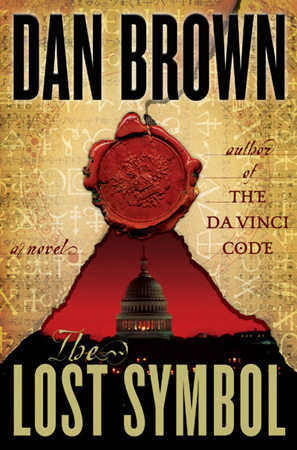
Dan Brown’s The Lost Symbol
I strongly disagree with avid Plotz’s commentary, Dan Brown’s Washington, which argues that the real story of Washington is in the political players, not the spiritual and philosophical history which is the focus of The Lost Symbol. Dan Brown’s power as a writer is in having his characters take an intellectual adventure, travelling down pathways of obscure knowledge and history. The Lost Symbol is at its most intriguing when the characters are just standing around reasoning, however misrepresented their facts may be at times.
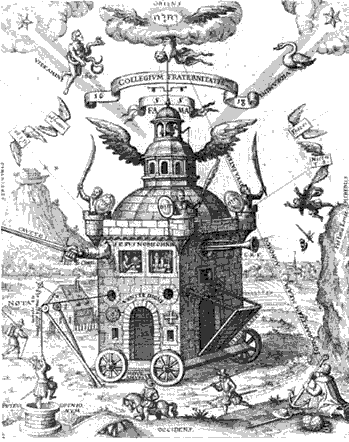
Rosicrucian Metaphor for the Invisible College
“The Temple of the Rosy Cross”
Credit: Teophilus Schweighardt Constantien
If you can remember that Dan Brown writes fiction and ride along with his storytelling with a notepad and a critical eye, you can discover some very fascinating things to look for in Washington DC and the Enlightenment Era. Thanks to Brown, I discovered the Invisible College, which was the precursor to the UK’s Royal Society, a society of scientists interested in understanding the world through empirical analysis. Today, the term serves to describe any method of attaining an education without going through an official academic route, similar to attending free courses online to get the knowledge, if not the course credit. The Rosicrucians was another fascinating concept, linked to the Invisible College, another secret society that may or may not have existed, but two anonymous manifestos were attributed to the organization, Fama fraternitatis and Confessio Fraternitatis, that stirred up much intellectual debate in Europe, and may have contributed to the Enlightenment movement. One individual rumored to have written the manifestos was Francis Bacon, who’s New Atlantis, also mentioned in Brown’s book, which depicted a utopian society founded on the principles of free inquiry and scientific research.
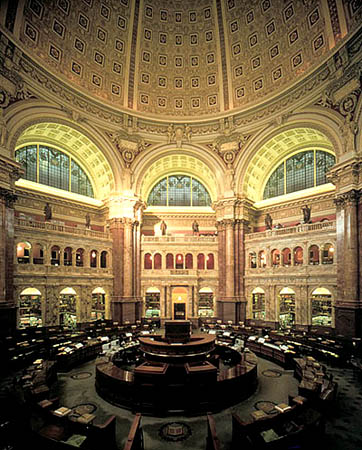
Library of Congress, Jefferson Reading Room
The Lost Symbol takes place across a wonderful variety of settings right around the Washington DC mall, which would be difficult to take in over the course of a week, much less during the single night in which Brown’s book takes place. He hits most of the science imagery found in the Jefferson Reading Room, a fantastic monument to science, knowledge, and Enlightenment values. The US Botanical Gardens, National Statuary Hall, and the Kryptos Sculpture outside CIA headquarters are just a few fascinating locations in the book and they serve as just a glance at the immense amount of history packed into the nation’s capital.
Brown has a penchant for silly academic scenes where Professor Robert Langdon wows awestruck students with seemingly incredible historical facts. The Lost Symbol delivers many of these, like when students mistake the pristine Smithsonian Castle for an ancient Norman castle so the Professor can correct them. But the Smithsonian is an incredible Institution, one that requires weeks to take in just what’s on display around the National Mall. Dan Brown introduces us to the Smithsonian Museum Support Center (SMSC), described in Smithsonian Magazine as the “Nation’s Attic,” which emphasizes that what the public can access in the museums is only a tiny fraction of the Smithsonian’s total collection. However, Brown’s book is a little out of date, as the squid and coelacanth referenced in the SMSC’s “Wet Pod” are currently on display at the Sant Ocean Hall in the Smithsonian museum of Natural History, which opened September 2008.
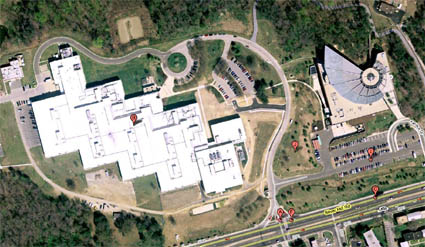
Smithsonian Museum Support Center (SMSC)
Via Google Maps
I never suspected there was anything at the Washington National Cathedral for me, an Enlightenment scholar, to appreciate; however, I am thankful to Dan Brown for introducing me to the Space Window, honoring the Moon landing, and includes a fragment of lunar rock brought back from an American lunar mission. The cathedral also features the head of Darth Vader as one of its gargoyles, voted by children as the scariest figure to fulfill the “role of the grotesque” in the architecture.
My favorite new Washington DC discovery in The Lost Symbol is the Apotheosis of Washington, the mural gracing the inside of the Capitol Building’s dome, which depicts the Founding Fathers and other great minds of their age receiving wisdom directly from the Roman gods. Ceres sits on a McCormick mechanical reaper, bringing agricultural science to Americans, Vulcan forges cannonballs in front of a steam engine, Venus helps to lay the transatlantic telegraph cable, and Minerva is shown bringing an electrical generator, batteries, and a printing press to the great American scientists Benjamin Franklin, Samuel Morse, and Robert Fulton.
The problem is that all of these real-world settings and details prime us to believe other, wholly fabricated aspects of Brown’s storytelling. I unquestioningly swallowed the falsehood that the Founding Father’s originally planned to call our nation’s capital “New Rome,” because I knew they were heavily influenced by the Greek Democracy and Roman Republic; however, I have found no evidence that the FF intended this whatsoever, and must assume that it has no basis in fact1.
Brown’s protagonist, Robert Langdon, asserts at one point that Google is not research. Maybe Brown fears his readers discovering snopes.com or other original sources where they can find out how he has exaggerated or misrepresented material. For instance, the way he overhypes the CIA’s Stargate Program, which experimented with remote viewing, but was cancelled without producing anything conclusive. Or the importance of the Noetic Sciences, which deals with supernatural ways of coming into knowledge, and, despite millions of books being sold on the subject, has yet to produce anything empirical. He mentions that meditating Yogis, produce a miraculous waxy substance from their pineal glands, but fails to mention this substance would be melatonin (there’s no evidence for Brown’s statement anyway). And, of course, 2012 has to make an appearance as well.
Brown ties together the facts that Isaac Newton’s temperature scale had 33 degrees (zero being freezing, 33 boiling), there are 33 Vertebrae in the human spine, and 33 degrees in the Scottish Rite of Freemasonry as proof that 33 is perceived as a powerful number in mysticism. If Dan Brown had wanted to weave the number into his storytelling a little more, he could have included Dante’s Divine Comedy (3 canticas with 33 cantos each), the number of segments in the United Nations’ symbol, and the coming of age for hobbits in the Lord of the Rings according to Wikipedia.
Where The DaVinci Code was focused on religious institutions suppressing knowledge to maintain their power, Lost Symbol focuses on ancient institutions trying to keep psychic powers out of mortal hands. Ancient societies had an awesome understanding of the universe that we modern folk are only just now beginning to discover, according to the book, and we simply aren’t ready for much of this forbidden knowledge. Everything we discover with modern physics was already written about in all the ancient texts. The Bible, for instance, contains this forbidden knowledge, but it’s hidden in the verse to prevent us from destroying ourselves with it. According to The Lost Symbol, America’s Founding Fathers were keenly aware of this:
It was here, Robert, at the very core of this young American nation, that our brightest forefathers–John Adams, Ben Franklin, Thomas Paine–all warned of the profound dangers of interpreting the Bible literally. In fact, Thomas Jefferson was so convinced the Bible’s true message was hidden that he literally cut up the pages and reedited the book, attempting, in his words, ‘to do away with the artificial scaffolding and restore the genuine doctrines.’
These words are technically true, but are highly misleading for the context in which they appear in The Lost Symbol. Dan Brown is trying to make it seem as if the Founding Fathers thought there was a hidden mystical meaning in the Bible, but this was not Thomas Jefferson’s intent in crafting his own version of the Bible. Jefferson started out constructing a simplified version of the New Testament that American Indians could easily understand, but turned to extracting what he considered Jesus’ true philosophical intent from what he came to see as the morass of supernatural embellishment the evangelicals had brought into the scriptures. Thomas Paine was highly critical of the Bible, not seeing a hidden mystical meaning, but a philosophy that he found morally reprehensible.
Dan Brown, in trying to prop up Noetic Sciences, ends up perpetuating an historical urban legend instead:
Peter once compared Noetic Scientists to the early explorers who were mocked for embracing the heretical notion of a spherical earth. Almost overnight, these explorers went from fools to heroes, discovering uncharted worlds and expanding the horizons of everyone on the planet.
This is nonsense and bad history. In American public schools we are taught that Columbus’ journey to find a western route to India was all the more amazing because everyone at the time thought the Earth was flat. While this makes his story more compelling, the reality was that the Earth’s spherical nature was a well-established fact. Aristotle knew the Earth was round in the third-century BC by observing its shadow on the Moon, Alexandria philosopher Eratosthenes had estimated the size of the Earth, and the early Romans were the first to suggest the idea of a westward route to India. Columbus’ opponents knew the Earth was round; however, they believed the explorer had grossly underestimated its size. Dan Brown is himself guilty of underestimating the “wisdom of the ancients2” in not knowing that the ancients knew the Earth was round.
The problem is, if you believe the conspiracy theory that all this powerful forbidden knowledge is being obfuscated by secret societies, then the fact that original documents reveal a truth that is devoid of supernaturalism, however intriguing their philosophical debates, then the lack of evidence is merely more support for the conspiracy to hide the “truth.” It’s a catch-22: there’s no evidence of a conspiracy to hide what the conspiracy theorist wants to believe; therefore, the conspiracy theorist takes this as evidence that the knowledge is being effectively hidden3.
I do appreciate Dan Brown bringing up Albert Einstein’s concept of a “Cosmic Religion,” which was the sense of spirituality Einstein got from uncovering the workings of the natural world and was best explained in his 1930s essay in the New York Times Magazine, Religion and Science:
…the cosmic religious feeling is the strongest and noblest motive for scientific research. Only those who realize the immense efforts, and, above all, the devotion without which pioneer work in theoretical science cannot be achieved are able to grasp the strength of the emotion out of which alone such work, remote as it is from the immediate realities of life, can issue. What a deep conviction of the rationality of the universe and what a yearning to understand, were it but a feeble reflection of the mind revealed in this world, Kepler and Newton must have had to enable them to spend years of solitary labor in disentangling the principles of celestial mechanics!
There is spirituality in this view of life, and there is hidden power to be revealed through scientific experimentation and empirical discovery. Just as “Any sufficiently advanced technology is indistinguishable from magic,” as Arthur C. Clarke said, Dan Brown is correct that “If our ancestors could see us today, surely they would think us gods.”
1 The only reference I could find to America and “New Rome” was as a pejorative in a commentary by Osama Bin Laden.
2 Part of the “wisdom of the ancients” Brown cites is the ingenuity of Alchemy, from which he conveniently leaves out the fact that his icon, Isaac “Jeova Sanctus Unus” Newton poisoned himself by playing with and tasting Mercury.
3 Full disclosure, I am a Discordian, so technically I am part of the conspiracy, but since organization is against the principles of Discordianism, it must purely be an emergent phenomenon.
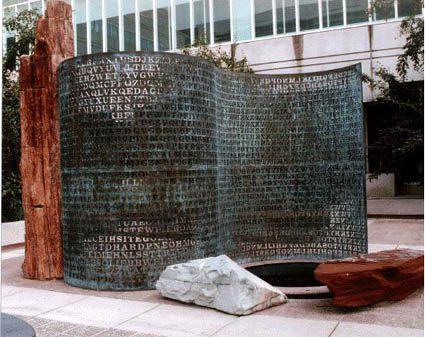
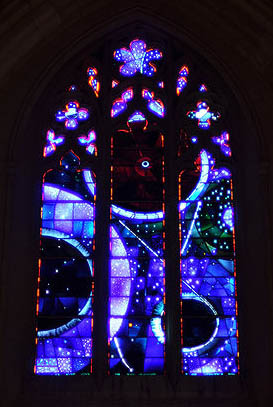

Comments
12 responses to “Enlightenment Truths and Metaphysical Inaccuracies in Dan Brown’s The Lost Symbol”